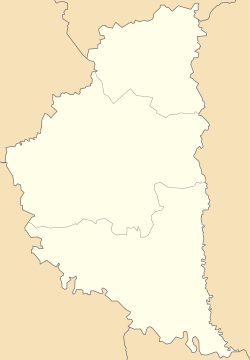Mukhavka
Mukhavka
Мухавка | |
|---|---|
 | |
| Coordinates: 48°54′7″N 25°43′31″E / 48.90194°N 25.72528°E | |
| Country | |
| Region | |
| Area | |
| Community | Nahirianka Hromada |
| First mentioned | 1469 |
| Time zone | UTC+2 (EET) |
| • Summer (DST) | UTC+3 (EEST) |
| Postal code | 48544 |
Mukhavka (Ukrainian: Мухавка, Polish: Muchhawka, German: Mukhavka) is a village iin Nahirianka rural hromada.,[1] Chortkiv Raion, Ternopil Oblast, Ukraine. The administrative center of the former Mukhav village council. According to the Polish and Austrian documents "List of populated places of the Ternopil District in 1867", the villages of Zhabyntsi, Pulyak and Stavky belonged to the village of Muhavka.
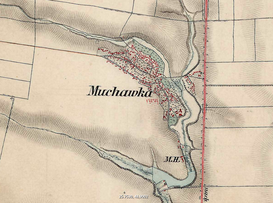

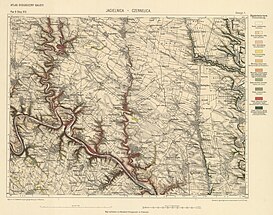



The village of Mukhavka is known from written sources since 1448.
Etymology[edit]
The most likely version of the origin of the name of the village of Mukhavka is that the name of the village is associated with the river Tupa (Dupla).
According to this version, the name of the village of Mukhavka comes from the large number of flies that lived in the river Tupa (Dupla). This version has a right to exist, since the river Tupa (Dupla) is a small river that is an ideal place for the reproduction of flies.
It is possible that the name of the village comes from this – Mukhavka.
This version is also supported by the fact that there are many other names of settlements in the Ukrainian language that are associated with flies. For example, the villages of Mukhlyaki, Mukholovka, and Mukhy.
Geography[edit]
The village of Muhavka is located on both banks of the Tupa River (Dupla, Pol. Dupa), the right tributary of the Seret River, the basin of the Dniester River. A cascade of 13 ponds has been created on the Tupa River, in front of the village, in the village itself and behind the village.
The distance to the district center — the city of Chortkiv — is 15 km, to the administrative center of the community — the village of Nahiryanka — 4 km. The road passes through the M19 and E85 international highway.
Localities[edit]
- Mukhavka is a village. On the right bank of the Tupa River are parts of the villages of Center, Dolishnya, Obranivka and Filvarok, on the left - Voloshchyna.
- Zhabyntsi is a hamlet (until 1970), located 1 km south of the village. In 1952, the farm had 5 yards and 15 inhabitants. In the mid-1970s, the inhabitants of the farm moved to the village of Mukhavka.
- Pulyak is a hamlet (until 1947), located 1.3 km south of the village. Mykhailo Pulyak's farm, the manor's mill and the miller's house were on the farm. In 1947, M. Pulyak's son Ivan and grandson Stepan were sentenced to 25 years in prison. I. Pulyak returned in 1953, his grandson in 1958; settled in the nearby village of Khomyakivka.
- Stavky (Wakaince) is a hamlet (until 1950) located 1.4 km northwest of the village. In 1949, the farm had 7 yards and 45 inhabitants.
History[edit]
Ancient times[edit]
Archaeological sites from the ancient times have been found near the village of Mukhavka.[2]
Middle Ages[edit]
In the 15th century, the village of Mushkavka was owned by the Buczacki family.
The first written mention of the village dates back to 1469.
In the 16th century, the village of Mushkavka passed into the ownership of the Lanckoroński family.
According to the "Geographical Dictionary of the Kingdom of Poland and Other Slavic Countries"[3] as of 1565, Iagilnicia and probably the surrounding villages, including the village of Mushkavka, were owned by the Lanckoroński family.
The ownership of the village of Mushkavka by the Lanckoroński family can be traced back to the following centuries, in particular, according to archival documents of the 18th century "List of Lanckoroński estates in 1770" and "List of taxes paid by the inhabitants of the village of Mushkavka to the Lanckoroński family in 1775", in the 19th century in the book "Cadastral description of the village of Mushkavka" of 1847 it is mentioned that the village of Mushkavka is owned by Count Jan Lanckoroński, in the book "Directory of all places located in the Kingdom of Galicia and Lodomeria, as well as in the Grand Duchy of Krakow and the Principality of Bukovina" [4] of 1885 it is mentioned that the village of Mushkavka is owned by Count Karol Lanckoroński.
| Spis katastralny wsi Muchawka
1847 rok Wieś Muchawka |
Cadastral Description of the Village of Mukhavka
1847 Mukhavka Village |
| Wieś Muchawka położona jest w powiecie Czortkowieckim, na terenie wsi Jagiełnica.
Wieś ma powierzchnię 804 morgi. Ludność wsi wynosi 1000 osób. W wsi znajduje się cerkiew prawosławna, szkoła i 2 karczmy. Ziemie wsi Muchawka są własnością Jego Wysokości hrabiego Jana Lanckorońskiego. W wsi znajdują się następujący właściciele działek gruntowych: · Jego Wysokość hrabia Jan Lanckoroński - 600 mórg; · Jan Krawiec - 100 mórg; · Michał Krawiec - 50 mórg; · Jan Iwanczuk - 50 mórg; · Michał Iwanczuk - 50 mórg. Wieś Muchawka ma następujące dochody: · z dzierżawy ziemi - 1000 złotych; · z podatków - 500 złotych. Wydatki wsi Muchawka: · na utrzymanie cerkwi prawosławnej - 200 złotych; · na utrzymanie szkoły - 100 złotych; · na utrzymanie karczm - 200 złotych. Czysty zysk wsi Muchawka wynosi 500 złotych. |
Mukhavka village is located in Chortkiv district, in the territory of Yagilnytsia volost.
The village has an area of 804 morgs. The population of the village is 1,000 people. The village has an Orthodox church, a school, and 2 taverns. The lands of Mukhavka village are owned by His Highness Count Jan Lanckoroński. The following owners of land plots are registered in the village: · His Highness Count Jan Lanckoroński - 600 morgs; · Ivan Kravets - 100 morgs; · Mykhailo Kravets - 50 morgs; · Ivan Ivanchuk - 50 morgs; · Mykhailo Ivanchuk - 50 morgs. Mukhavka village has the following incomes: · from land rent - 1,000 zloty; · from taxes - 500 zloty. Mukhavka village expenses: · for the maintenance of the Orthodox church - 200 zloty; · for the maintenance of the school - 100 zloty; · for the maintenance of the taverns - 200 zloty. The net profit of Mukhavka village is 500 zloty. |
According to the "Geographical Dictionary of the Kingdom of Poland and Other Slavic Countries, "Vol.6",[5] published in 1885, on pages 790-791, it is stated that the village of Muhavka belonged to the estate complex of the village of Jagielnytsia, also known as Jagielnytsia key, which the Liantskoronski family owned until 1939
| Muchawka, wś, pow. czortkowski, nad rz. Dupą, o 6 km. na płd. od Jagielnicy i tyleż na płd. od Tłustego, przy gościńcu rządowym lwowskozaleszczyckim, graniczy na wschód z Ułaszkowcami i Milowcami, na płd. ze Swidową, ną zach. z Antonowem, na płn. z Nagorzanką, przedmieściem Jagielnicy, leży w najlepszej podolskiej glebie; oprócz zwykłych zboż udaje się tu doskonale kukurydza i tytuń, którego znaczne plantacye utrzymują włościanie dla pobliskiej fabryki tytoniu w Jagielnicy; obszar dwor. grun. orne 872, łąk 94 pastw. 9; włośc. grun. orne 1376, łąk 68, pastw. 2 kw. , mr. ; ludn. rzym. kat. 222, par. w Jagielnicy, gr. kat. 680, par. Świdowa, szkoła filialna o 1 nauczycielu, kasa pożyczk, z kapit. 1600 zł. a. w. Sąd pow. Czortków, urząd poczt. Jagielnica. Należy z całym kluczem ułaszkowieckim do Karola hr. Lanckorońskiego. | Mukhavka, a village in the Chortkiv district, on the Tupa River, about 6 km south of Yagilnytsia and exactly south of Tluste, on the state road Lviv-Zalishchyky, borders on the east with Ulashkivtsi and Milivtsi, on the south with Svidova, on the west with Antonov, on the north with Nahyrianka, a suburb of Yagilnytsia, lies in the best Podolian land; in addition to ordinary cereals, corn and tobacco grow very well here, large plantations of which are maintained by the peasants for the neighboring tobacco factory in Yagilnytsia; overview of the territory: arable land 872, meadows 94 pastures. 9; arable land in the volost 1376, meadows 68, pastures 2 square morgs; population: r-kat. 222 to the parish in Yagilnytsia, gr.-kat. 680 to the parish in Svidova, a branch school with 1 teacher, a credit union with a capital of 1600 zlotys. district court in Chortkiv, post office in Yagilnytsia. Belongs with the entire Ulashkivtsi key to Count Karol Lanckoroński. |
| Słownik geograficzny Królestwa Polskiego i innych krajów słowiańskich. T.6, s.790-791 | Geographical Dictionary of the Kingdom of Poland and other Slavic territories. Vol. 6, p. 790-791 |
The Yagilnicza estate encompassed the lands around the towns of Yagilnytsia and Ulashkivtsi, as well as the villages of Antonów, Chomyakivka, Dolina, Nahyrianka, Mukhavka, Swidova, Sosulivka, Stara Yagilnytsia , Rosokhach, Saliwka, Shulhanivka, and Zabolotivka. It consisted of 14 manors. The manors in the villages of Stara Yagilnytsia, Rosokhach, Sosulivka, Mukhavka, Swidova, and Antonów were leased out.
Two distilleries, a brewery, several water mills, bakeries, and a brickyard operated on the territory of the Yagilnicza estate. In the village of Muhawka itself, there was a distillery and a water mill.[6]
According to the administrative division of the 16th century, the village of Mukhavka belonged to the Kamieniec Podolski county of the Podolia voivodeship.
Under the Treaty of Buchach (1672), the village of Mukhavka was under the rule of the Ottoman Empire from 1672 to 1684 and belonged to the Chortkiv nahie of the Kamieniec Podolski eyalet of the Podolia pashalik.
After the First Partition of Poland in 1772, the village of Mukhavka belonged to the Austrian possessions of the Habsburgs in the Holy Roman Empire (from 1804, the Austrian Empire, from 1867, Austria-Hungary). It belonged to the Zalishchyky, later Chortkiv district of the "kreisy".
In 1809-1815, the village of Mukhavka belonged to the Russian Empire as one of the villages of the Chortkiv district of the Ternopil region.
In 1867-1918, the Mukhavka community (gmina) belonged to the Chortkiv district of the crownland of the Kingdom of Galicia and Lodomeria, part of the Austrian Empire, from 1867, Austria-Hungary.
XX Century[edit]
In 1907, elections were held in the village of Mukhavka, from the 69th district,[7] to the Vienna Parliament. 356 votes out of 404 valid and 407 cast out of 442 registered voters from the village of Mukhavka (including voters from the village of Antoniv) were received by the pro-Ukrainian candidate Dr. A. Kolessa, other candidates: Dr. Jan Socha, Polish national candidate; Dr. A. Mahler, Zionist candidate; K. Wojewoda, radical Polish candidate; Ks. D. Biliński, Moscovite candidate; J. lir. Baworowiki, conservative Polish candidate and W. Hładysz, Russian socialist received the remaining 48 votes.
During World War I, a resident of Mukhavka, Volodymyr Kotsyuk, volunteered for the Ukrainian Galician Army (UGA).
In 1918, the village of Mukhavka became part of the West Ukrainian People's Republic (ZUNR).
During the Polish-Ukrainian War, on June 7, 1919, during the offensive known in history as the Chortkiv Offensive, with a blow through the village of Muhavka, the UHA broke through the Polish front and captured Yagilnytsia, and the next day liberated Chortkiv. An excerpt from "Memoirs of the Liberation War of the Ataman Alexander Hnizdovsky", which describes the battles that took place through the village of Mukhavka.[8]
In 1920, the village of Mukhavka was annexed to the Polish Republic, and the property was transferred under the management of the Polish state.
Since August 1, 1934, Muhavka belonged to the gmina of Svidova, Chortkiv County, Ternopil Voivodeship.
From 1939 to 1941 and from 1944 to 1991, the village of Mukhavka belonged to the Chortkiv district of Ternopil region of the Ukrainian Soviet Socialist Republic.
During 1939-1941, 19 residents of the village were held in the Chortkiv NKVD prison, of whom 3 were tortured and executed - Vasyl Barytsky, Karl Okhvat and Mykola Strotsen.[9]
From July 1941, during World War II, the village of Mukhavka was under German occupation. On April 14, 1944, the village of Mukhavka was liberated, together with other neighboring villages of Tluste, Antoniv, Yagilnytsia, Shulganivka, and Stara Yagilnytsia.[10]
According to the report of the district research commission (district research commission) dated 07/01/44, there was a camp for Jewish people (ghetto) in the village of Mukhavka, which housed about 200 people, who were almost all killed during 1941-1944 (State Archive of the Russian Federation, fund R-7021, description 75, case 107, sheet 324 back, pages 95–96, 98).[11]
During World War II, 36 residents of the village were killed or went missing.
In 1943-1945, an underground printing house operated in Mukhavka, which published the newspaper "Svoboda".
Until the mid-1950s, armed struggle of the OUN-UPA underground continued in the village. Stepan Barytsky, Ivan Burynyuk, Yosyp Vynarchuk, Stepan Vozhnyi, Mykhailo Zhegus, Petro Kokhan, Ivan Suchelnytskyi and many others fought in the UPA units.
New times[edit]
In 1992, a symbolic grave was erected for all those who fought for the independence of Ukraine. A steel cross with the inscription "Glory to the fighters who fell for the freedom of Ukraine" was erected on the grave, and a chapel of the Mother of God (1908) was built nearby. The grave was consecrated on August 24, 1992, in honor of the first anniversary of Ukraine's Independence Day.
In 1994, a train stop was opened in the village of Mukhavka. This was facilitated by the former school director Grushchych P.T., the head of the village council Berezovsky G.R., and the People's Deputy of Ukraine Mr. Metyuk. A small stop with a platform was built in Mukhavka, and electricity was supplied. On August 19, on Spas, the train connecting Ternopil - Chernivtsi stopped for the first time in the village of Mukhavka.
Girls in embroidered shirts met him with bread and salt, and the head of the village council Mr. Berezovsky awarded the locomotive driver with a wreath of periwinkle.
In 1998, the memorial cross in honor of the abolition of serfdom was completely restored (it was originally wooden). This cross was destroyed twice. The first time, partially in 1943, after which it was placed on a low pedestal; in 1948, the cross was completely destroyed. In 1968, the cross was partially restored.
Since December 1, 2020, Mukhavka has been part of the Nagoryanska rural community.[12]
Religion[edit]
Greek Catholic Church
It is likely that there was a church in the village of Mukhavka at the beginning or in the middle of the 18th century. This church was wooden and was dedicated to St. Paraskeva.
1779 - The first known image of the Church of St. Paraskeva in the village of Mukhavka on a topographic map of the Kingdom of Galicia and Volhynia in 1779-1783.
1784 - The first written mention, in the publication of the UGCC "Schematism of the All-Holy Clergy of the Greek Catholic Diocese of Stanislaviv in 1887", about the keeping of a separate metric for the village of Mukhavka at the Church of St. Paraskeva: records of birth, baptism, marriage and death.
- Church of St. Paraskeva Ternovska (UGCC, wooden, 1860). Since 1990, it has been transferred to the status of a Worship Chapel, in which the "Parental Icon" museum was opened in 2012.
- Church of St. Paraskeva Ternovska (UGCC, stone, 1926). In 2002, a two-storey stone bell tower was built next to the church.
- Chapel of Jesus Christ (2013).
- Chapel of the Mother of God (2013).
Roman Catholic church
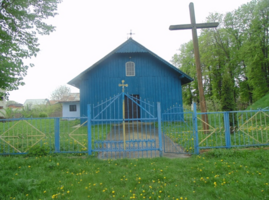 |
 |
 |
Monuments[edit]
- Taras Shevchenko Monument (1959).
- Memorial to Soldiers from the Local Area Who Died in World War II (1969).[13]
- Figure of Saint Yuri, near the old wooden church, where there was once a cemetery (on the territory of the present park, opposite the school).
- A symbolic grave with a chapel of the Mother of God and an iron cross dedicated to the Fighters for the Freedom of Ukraine.
- A memorial cross dedicated to the abolition of serfdom.
 |
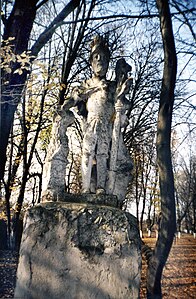 |
 |
Education, social sphere, economy[edit]
According to written sources, a school has been operating in the village of Mukhkavka since the second half of the 19th century:
- Under Austro-Hungary:
- 1870 — the first written mention of a primary school in the village of Mukhavka (szkoła trywialna), with teacher Marcin Gocko (Gocko Marcin).[14]
- 1891 — a one-class school with Ukrainian language of instruction (93 children).[15][16]
- 1910 — a modern school building was built.
- 1913 — a two-class school with Ukrainian language of instruction.[17][18]
- Under the Polish Republic:
- Under the Ukrainian Soviet Socialist Republic:
- 1949 — the school was reorganized into a seven-year school.
- 1952 — the first graduation of Mukhavka seven-year school.
- 1958 — the school building was expanded.
- 1961 — the first graduation of eight-year school.
- 1964 — Another school building was built.
- Under independent Ukraine:
- 1991 — the school was reorganized into a nine-year school.
Social sphere
Since the end of the 19th and early 20th centuries, branches of the following societies have been operating in the village: «Prosvita», «Sich», «Lug», «Sokol» (1934),[21] «Skala» (1934 р.),[21]«Silsky Gospodar», «Union of small-scale nobility» (1939 р.),[21] «Association of Folk Schools» (1937 р.).[21]
Girls from the village: Zosya Smityukh, Yustia Strotsen, Dominika Strotsen, and others were members of the organization "Soyuz Ukrainok" (1938).[21]
In the 1890s, a «Prosvita» reading room was founded, which had a library (destroyed during World War I).
The village of Mukhavka also had branches of financial institutions: the Ukrainian cooperative "Nedila" (1922) and the Ukrainian cooperative "Yednist" (1927).
In 1990-1991, a new House of Culture was built, which also houses the Mukhavka Village Council and the Village Library.
Currently, there is a kindergarten, a general practice and family medicine clinic, shopping establishments, "Fortuna" and "Bagrii" farms.
 |
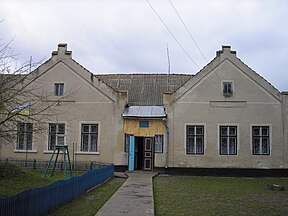 |
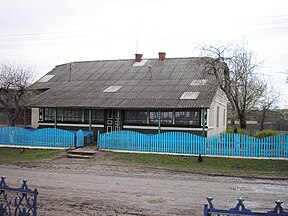 |
Economy

It seems likely that the ponds on the Tupa River in the village of Muhavka were created shortly after the village was founded.
In the 19th century, their reconstruction (expansion) took place to increase the volume of fish farming and more effective irrigation of fields. The ponds had to have an area of at least 100 square fathoms and a depth of at least 1.5 meters.
In the 20th century, during the time of the Polish Republic, as part of the land reclamation program in Galicia in 1930-1939, the construction of new ponds began in the village of Muhavka in 1936 and was completed in 1938. Their number increased to 13, the depth of the ponds was increased to about 2 meters, and the area of the largest was about 10 hectares.
The ponds were intended for fish farming. Industrial fish farming in the ponds of the village of Muhavka took place until the mid-2000s.
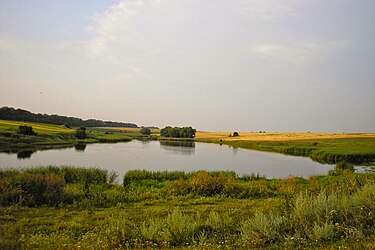 |
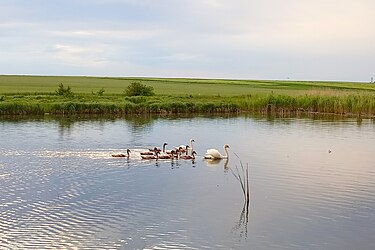 |
| Ponds in the village of Muhavka | |
Now the ponds are owned by the village of Mukhavka and are an important element of the infrastructure of the village, as well as a place of rest for both local residents and numerous vacationers from the entire district.
Population[edit]
According to the All-Ukrainian population census of 2001, 706 people lived in the village.[22]
| Distribution of the population by native language
according to the 2001 census: [22] | ||||
|---|---|---|---|---|
| Language | Population size | Percentage | ||
| Ukrainian | 693 | 706 | 98,16% | 100% |
| Russian | 13 | 1,84% | ||
As of 2020, the population of the village has decreased to 615 people.
| Year | Population size village Mukhavka
from 1836 to 2020 | |||
|---|---|---|---|---|
| Ukrainians | Latins
and Poles |
Jews | In general | |
| 1836[23] | 641 | 641 | ||
| 1839[24] | 642 | 642 | ||
| 1840[25] | 695 | 695 | ||
| 1842[26] | 678 | 678 | ||
| 1843[27] | 690 | 690 | ||
| 1844[28] | 730 | 730 | ||
| 1845[29] | 632 | 632 | ||
| 1848[30] | 706 | 706 | ||
| 1850[31] | 690 | 690 | ||
| 1851[32] | 705 | 705 | ||
| 1855[33] | 632 | 632 | ||
| 1856[34] | 631 | 631 | ||
| 1857[35] | 631 | 631 | ||
| 1858[36] | 631 | 631 | ||
| 1859[37] | 633 | 633 | ||
| 1860[38] | 645 | 645 | ||
| 1861[39] | 621 | 621 | ||
| 1862[40] | 633 | 633 | ||
| 1863[41] | 648 | 648 | ||
| 1864[42] | 635 | 635 | ||
| 1865[43] | 640 | 640 | ||
| 1866[44] | 644 | 644 | ||
| 1867[45] | 638 | 638 | ||
| 1868[46] | 680 | 680 | ||
| 1871[47] | 690 | 690 | ||
| 1872[48] | 708 | 708 | ||
| 1874[49] | 702 | 702 | ||
| 1875[50] | 709 | 709 | ||
| 1876[51] | 704 | 704 | ||
| 1877[52] | 706 | 706 | ||
| 1878[53] | 697 | 697 | ||
| 1879[54] | 678 | 678 | ||
| 1880[55] | 678 | 678 | ||
| 1881[56] | 778 | 778 | ||
| 1882[57][58] | 680 | 680 | ||
| 1883[59] | 680 | 680 | ||
| 1886[60] | 800 | 800 | ||
| 1887[61] | 800 | 800 | ||
| 1888[62] | 810 | 810 | ||
| 1890[63] | 800 | 800 | ||
| 1891[64] | 810 | 810 | ||
| 1892[65] | 924 | 6 | 60 | 990 |
| 1894[66] | 924 | 924 | ||
| 1895[67] | 958 | 250 | 38 | 1246 |
| 1896[68] | 972 | 180 | 32 | 1184 |
| 1897[69] | 983 | 172 | 27 | 1182 |
| 1898[70] | 995 | 163 | 27 | 1185 |
| 1899[71] | 1010 | 153 | 30 | 1193 |
| 1900[72] | 990 | 152 | 28 | 1170 |
| 1901[73] | 1009 | 150 | 28 | 1187 |
| 1902[74] | 1029 | 154 | 28 | 1211 |
| 1903[75] | 1030 | 156 | 28 | 1214 |
| 1904[76] | 1055 | 158 | 26 | 1239 |
| 1905[77] | 1050 | 150 | 27 | 1227 |
| 1906[78] | 1039 | 147 | 26 | 1212 |
| 1907[79] | 1044 | 151 | 27 | 1222 |
| 1909[80] | 1090 | 160 | 23 | 1273 |
| 1910[81] | 1100 | 147 | 26 | 1273 |
| 1911[82] | 1110 | 150 | 28 | 1288 |
| 1912[83] | 1156 | 159 | 32 | 1347 |
| 1913[84] | 1178 | 162 | 32 | 1372 |
| 1914[85] | 1190 | 161 | 30 | 1381 |
| 1921[86] | 1195 | |||
| 1925[87] | 1100 | 300 | 48 | 1448 |
| 1927[88] | 1100 | 293 | 20 | 1413 |
| 1929[89] | 1100 | 294 | 21 | 1415 |
| 1930[90] | 954 | 274 | 21 | 1249 |
| 1931[91] | 957 | 275 | 21 | 1253 |
| 1935[92] | 993 | 285 | 18 | 1296 |
| 1938[93] | 1005 | 301 | 18 | 1324 |
| 1939[94] | 1020 | 340 | 20 | 1380 |
| 1993 | 678 | |||
| 2001[22] | 706 | |||
| 2014 | 620 | |||
| 2018[95] | 628 | |||
| 2020 | 615 | |||
Famous people[edit]
Were born[edit]
- Joachim Kardinal (1889-1960) is an entrepreneur, public figure in Canada;
- Volodymyr Tarnavskyi (1912-2002) was a religious and public figure in Canada;
- Maria-Yaroslava Tarnavska-Kosovska (1921—2002) — writer;
- Dmytro Kovtsun (September 29, 1955) is a Ukrainian track and field athlete, a participant in the Olympic Games.
References[edit]
- ^ Нагірянська територіальна громада, Децентралізація
- ^ Тернопільська обласна державна адміністрація № 07-5714/42-29 від 19.09.2018. "Перелік пам'яток археології та об'єктів культурної спадщини (археології) м. Чортків та Чортківського району, що перебувають на державному обліку" (PDF). www.oda.te.gov.ua.
{{cite web}}: CS1 maint: numeric names: authors list (link) - ^ "Słownik geograficzny Królestwa Polskiego i innych krajów słowiańskich. T. 15".
- ^ "Skorowidz wszystkich miejscowości położonych w królestwie Galicyi i Lodomeryi jakoteż w wielkim księstwie Krakowskiem i księstwie Bukowińskiem, pod względem politycznej i sądowej organizacyi kraju wraz z dokładnem oznaczeniem parafii, poczt i właścicieli tabularnych, ułożony porządkiem abecadłowym". Łowiecka Biblioteka Cyfrowa Krzysztofa Daszkiewicza. 1855. Retrieved 2023-11-30.
- ^ "Słownik geograficzny Królestwa Polskiego i innych krajów słowiańskich, Tom VI - wynik wyszukiwania - DIR". dir.icm.edu.pl. Retrieved 2023-11-29.
- ^ Repozytorium Cyfrowe Instytutów Naukowych, 2020-10-19, retrieved 2023-11-29
- ^ Dubanowicz, Edward (1881-1943); Dubanowicz, Edward (1881-1943) (1907). "Stanowisko ludności żydowskiej w Galicyi wobec wyborów do parlamentu wiedeńskiego w r. 1907". IBL PAN, sygn. F.21.917. Retrieved 2023-11-30.
{{cite news}}: CS1 maint: numeric names: authors list (link) - ^ "Memories of the liberation war of Oleksandr Hnizdovsky of Bunchuzhny, a resident of the village of Mytkiv of the Zastavniv district // Chác. — Chernivtsi, 2002. No. 17. 30. Vynnychenko V. Diary. — Edmonton-New York, 1980".
- ^ Упор. О. Г. Бажан, П. З. Гуцал, Л. М. Кіт. – Тернопіль: ТОВ “Терно-граф”, 2018. "Реабілітовані історією. Тернопільська область. Книга п'ята" (PDF).
{{cite web}}: CS1 maint: multiple names: authors list (link) CS1 maint: numeric names: authors list (link) - ^ "ХРОНІКА ВИЗВОЛЕННЯ НАСЕЛЕНИХ ПУНКТІВ УКРАЇНИ (1943 - 1944 р р.): день за днем..."
- ^ Довідник про табори, тюрми та гетто на окупованій території України (1941-1944) / Ред. кол.: Г. В. Боряк, О. Є. Лисенко, І. М. Лушніков, Є. С. Максимчук, Р. Я. Пиріг, Г. Д. Рябоконь, В. Й.Скаковська, П. М. Шатковський, Ю. С. Шемшученко; Упоряд. матеріалів, передм. М. Г. Дубик; Наук. ред. Г. В. Папакін. Державний комітет архівів України; Український національний фонд "Взаєморозуміння і примирення". ‒ К., 2000. ‒ 304 с. (PDF).
- ^ Габруський, Л. (2020-12-03). "На Чортківщині ОТГ провели свої перші сесії". Голос народу (49): 2.
- ^ "ПЕРЕЛІК пам'яток історії Тернопільської області не занесених до Державного реєстру нерухомих пам'яток України" (PDF).
- ^ "Szematyzm Królestwa Galicyi i Lodomeryi z Wielk. Księstwem Krakowskiem: na rok 1870".
- ^ "Šematizm Vsego Klira Greko-Katoličeskoj Eparhii Stanislavovskoj na Rok' Božij 1891". Biblioteka Uniwersytecka Kul.
- ^ "Szematyzm Królestwa Galicyi i Lodomeryi z Wielk. Księstwem Krakowskiem: na rok 1892".
- ^ "Szematyzm Królestwa Galicyi i Lodomeryi z Wielk. Księstwem Krakowskiem: na rok 1913".
- ^ "Šematizm Vsego Klira Greko-Katoličeskoï Eparhiï Stanislavovskoï na Rik Božij 1913". Biblioteka Uniwersytecka Kul.
- ^ "Šematizm Vsego Klira Greko-Katoličeskoï Eparhiï Stanislavovskoï na Rik Božij 1925". Biblioteka Uniwersytecka Kul.
- ^ "Šematizm Vsego Klira Greko-Katoličeskoï Eparhiï Stanislavovskoï na Rik Božij 1927". Biblioteka Uniwersytecka Kul.
- ^ a b c d e Державний архів Тернопільської області. Фонди до вересня 1939 року. "Чортківське повітове староство, м. Чортків Тернопільського воєводства (1919–1939 рр.)" (PDF). te.archives.gov.ua.
{{cite web}}: CS1 maint: numeric names: authors list (link) - ^ a b c "Рідні мови в об'єднаних територіальних громадах України". socialdata.org.ua (in Ukrainian). Retrieved 2023-12-12.
- ^ Piller, Piotr. "Schematismus Universi Venerabilis Cleri Archidioeceseos Metropolitanae Graeco Catholicae Leopoliensis pro Anno Domini 1836". Biblioteka Uniwersytecka Kul.
- ^ Schematismus Universi Venerabilis Cleri Archidioeceseos Metropolitanae Graeco Catholicae Leopoliensis pro Anno Domini 1839. Piller. 1839.
- ^ Piller, Piotr. "Schematismus Universi Venerabilis Cleri Archidioeceseos Metropolitanae Graeco Catholicae Leopoliensis pro Anno Domini 1840". Biblioteka Uniwersytecka Kul.
- ^ Piller, Piotr. "Schematismus Universi Venerabilis Cleri Archidioeceseos Metropolitanae Graeco Catholicae Leopoliensis pro Anno Domini 1842". Biblioteka Uniwersytecka Kul.
- ^ Piller, Piotr. "Schematismus Universi Venerabilis Cleri Archidioeceseos Metropolitanae Graeco Catholicae Leopoliensis pro Anno Domini 1843". Biblioteka Uniwersytecka Kul.
- ^ Piller, Piotr. "Schematismus Universi Venerabilis Cleri Archidioeceseos Metropolitanae Graeco Catholicae Leopoliensis pro Anno Domini 1844". Biblioteka Uniwersytecka Kul.
- ^ Piller, Piotr. "Schematismus Universi Venerabilis Cleri Archidioeceseos Metropolitanae Graeco Catholicae Leopoliensis pro Anno Domini 1845". 10000 - Biblioteka Uniwersytecka Kul.
- ^ Piller, Piotr. "Schematismus Universi Venerabilis Cleri Archidioeceseos Metropolitanae Graeco Catholicae Leopoliensis pro Anno Domini 1848". 10000 - Biblioteka Uniwersytecka Kul.
- ^ Piller, Piotr. "Schematismus Universi Venerabilis Cleri Archidioeceseos Metropolitanae Graeco Catholicae Leopoliensis pro Anno Domini 1850". Biblioteka Uniwersytecka Kul.
- ^ Piller, Piotr. "Schematismus Universi Venerabilis Cleri Archidioeceseos Metropolitanae Graeco Catholicae Leopoliensis pro Anno Domini 1851". Biblioteka Uniwersytecka Kul.
- ^ Piller, Piotr. "Schematismus Universi Venerabilis Cleri Archidioeceseos Metropolitanae Graeco Catholicae Leopoliensis pro Anno Domini 1855". Biblioteka Uniwersytecka Kul.
- ^ Piller, Piotr. "Schematismus Universi Venerabilis Cleri Archidioeceseos Metropolitanae Graeco Catholicae Leopoliensis pro Anno Domini 1856". 10000 - Biblioteka Uniwersytecka Kul.
- ^ Piller, Piotr. "Schematismus Universi Venerabilis Cleri Archidioeceseos Metropolitanae Graeco Catholicae Leopoliensis pro Anno Domini 1857". 10000 - Biblioteka Uniwersytecka Kul.
- ^ Piller, Piotr. "Schematismus Universi Venerabilis Cleri Archidioeceseos Metropolitanae Graeco Catholicae Leopoliensis pro Anno Domini 1858". 10000 - Biblioteka Uniwersytecka Kul.
- ^ Piller, Piotr. "Schematismus Universi Venerabilis Cleri Archidioeceseos Metropolitanae Graeco Catholicae Leopoliensis pro Anno Domini 1859". 10000 - Biblioteka Uniwersytecka Kul.
- ^ Piller, Piotr. "Schematismus Universi Venerabilis Cleri Archidioeceseos Metropolitanae Graeco Catholicae Leopoliensis pro Anno Domini 1860". 10000 - Biblioteka Uniwersytecka Kul.
- ^ Piller, Piotr. "Schematismus Universi Venerabilis Cleri Archidioeceseos Metropolitanae Graeco Catholicae Leopoliensis pro Anno Domini 1861". Biblioteka Uniwersytecka Kul.
- ^ Piller, Piotr. "Schematismus Universi Venerabilis Cleri Archidioeceseos Metropolitanae Graeco Catholicae Leopoliensis pro Anno Domini 1862". Biblioteka Uniwersytecka Kul.
- ^ Piller, Piotr. "Schematismus Universi Venerabilis Cleri Archidioeceseos Metropolitanae Graeco Catholicae Leopoliensis pro Anno Domini 1863". Biblioteka Uniwersytecka Kul.
- ^ Piller, Piotr. "Schematismus Universi Venerabilis Cleri Archidioeceseos Metropolitanae Graeco Catholicae Leopoliensis pro Anno Domini 1864". 10000 - Biblioteka Uniwersytecka Kul.
- ^ Piller, Piotr. "Schematismus Universi Venerabilis Cleri Archidioeceseos Metropolitanae Graeco Catholicae Leopoliensis pro Anno Domini 1865". 10000 - Biblioteka Uniwersytecka Kul.
- ^ Piller, Piotr. "Schematismus Universi Venerabilis Cleri Archidioeceseos Metropolitanae Graeco Catholicae Leopoliensis pro Anno Domini 1866". 10000 - Biblioteka Uniwersytecka Kul.
- ^ Piller, Piotr. "Schematismus Universi Venerabilis Cleri Archidioeceseos Metropolitanae Graeco Catholicae Leopoliensis pro Anno Domini 1867". 10000 - Biblioteka Uniwersytecka Kul.
- ^ Piller, Piotr. "Schematismus Universi Venerabilis Cleri Archidioeceseos Metropolitanae Graeco Catholicae Leopoliensis pro Anno Domini 1868". 10000 - Biblioteka Uniwersytecka Kul.
- ^ Piller, Piotr. "Schematismus Universi Venerabilis Cleri Archidioeceseos Metropolitanae Graeco Catholicae Leopoliensis pro Anno Domini 1871". 10000 - Biblioteka Uniwersytecka Kul.
- ^ Piller, Piotr. "Schematismus Universi Venerabilis Cleri Archidioeceseos Metropolitanae Graeco Catholicae Leopoliensis pro Anno Domini 1872". 10000 - Biblioteka Uniwersytecka Kul.
- ^ Piller, Piotr. "Schematismus Universi Venerabilis Cleri Archidioeceseos Metropolitanae Graeco Catholicae Leopoliensis pro Anno Domini 1874". Biblioteka Uniwersytecka Kul.
- ^ Piller, Piotr. "Schematismus Universi Venerabilis Cleri Archidioeceseos Metropolitanae Graeco Catholicae Leopoliensis pro Anno Domini 1875". Biblioteka Uniwersytecka Kul.
- ^ Piller, Piotr. "Schematismus Universi Venerabilis Cleri Archidioeceseos Metropolitanae Graeco Catholicae Leopoliensis pro Anno Domini 1876". Biblioteka Uniwersytecka Kul.
- ^ Piller, Piotr. "Schematismus Universi Venerabilis Cleri Archidioeceseos Metropolitanae Graeco Catholicae Leopoliensis pro Anno Domini 1877". Biblioteka Uniwersytecka Kul.
- ^ Piller, Piotr. "Schematismus Universi Venerabilis Cleri Archidioeceseos Metropolitanae Graeco Catholicae Leopoliensis pro Anno Domini 1878". Biblioteka Uniwersytecka Kul.
- ^ Piller, Piotr. "Schematismus Universi Venerabilis Cleri Archidioeceseos Metropolitanae Graeco Catholicae Leopoliensis pro Anno Domini 1879". 10000 - Biblioteka Uniwersytecka Kul.
- ^ Piller, Piotr. "Schematismus Universi Venerabilis Cleri Archidioeceseos Metropolitanae Graeco Catholicae Leopoliensis pro Anno Domini 1880". 10000 - Biblioteka Uniwersytecka Kul.
- ^ Piller, Piotr. "Schematismus Universi Venerabilis Cleri Archidioeceseos Metropolitanae Graeco Catholicae Leopoliensis pro Anno Domini 1881". 10000 - Biblioteka Uniwersytecka Kul.
- ^ Piller, Piotr. "Schematismus Universi Venerabilis Cleri Archidioeceseos Metropolitanae Graeco Catholicae Leopoliensis pro Anno Domini 1882". Biblioteka Uniwersytecka Kul.
- ^ "Šematizm Vsečestnogo Klira Mitropol. Arhidiecezii Greko-Katoličeskoj L'vovskoj na Rok' 1882". Biblioteka Uniwersytecka Kul.
- ^ "Šematizm Vsečestnogo Klira Mitropol. Arhidiecezii Greko-Katoličeskoj L'vovskoj na Rok' 1883". Biblioteka Uniwersytecka Kul.
- ^ "Šematizm Vsečestnogo Klira Episkopskoj Diecezii Greko-Katoličeskoj Stanislavovskoj na Rok' Božij 1886". Biblioteka Uniwersytecka Kul.
- ^ "Šematizm Vsečestnogo Klira Episkopskoj Diecezii Greko-Katoličeskoj Stanislavovskoj na Rok' Božij 1887". 10000 - Biblioteka Uniwersytecka Kul.
- ^ "Šematizm Vsečestnogo Klira Episkopskoj Diecezii Greko-Katoličeskoj Stanislavovskoj na Rok' Božij 1888". 10000 - Biblioteka Uniwersytecka Kul.
- ^ "Šematizm Vsečestnogo Klira Episkopskoj Diecezii Greko-Katoličeskoj Stanislavovskoj na Rok' Božij 1890". 10000 - Biblioteka Uniwersytecka Kul.
- ^ "Šematizm Vsečestnogo Klira Episkopskoj Diecezii Greko-Katoličeskoj Stanislavovskoj na Rok' Božij 1891". Biblioteka Uniwersytecka Kul.
- ^ "Šematizm Vsečestnogo Klira Episkopskoj Diecezii Greko-Katoličeskoj Stanislavovskoj na Rok' Božij 1892". Biblioteka Uniwersytecka Kul.
- ^ "Šematizm Vsečestnogo Klira Episkopskoj Diecezii Greko-Katoličeskoj Stanislavovskoj na Rok' Božij 1894". Biblioteka Uniwersytecka Kul.
- ^ "Šematizm Vsečestnogo Klira Episkopskoj Diecezii Greko-Katoličeskoj Stanislavovskoj na Rok' Božij 1885". Biblioteka Uniwersytecka Kul.
- ^ "Šematizm Vsečestnogo Klira Episkopskoj Diecezii Greko-Katoličeskoj Stanislavovskoj na Rok' Božij 1886". Biblioteka Uniwersytecka Kul.
- ^ "Šematizm Vsečestnogo Klira Episkopskoj Diecezii Greko-Katoličeskoj Stanislavovskoj na Rok' Božij 1897". Biblioteka Uniwersytecka Kul.
- ^ "Šematizm Vsečestnogo Klira Episkopskoj Diecezii Greko-Katoličeskoj Stanislavovskoj na Rok' Božij 1898". Biblioteka Uniwersytecka Kul.
- ^ "Šematizm Vsečestnogo Klira Episkopskoj Diecezii Greko-Katoličeskoj Stanislavovskoj na Rok' Božij 1899". Biblioteka Uniwersytecka Kul.
- ^ "Šematizm Vsečestnogo Klira Episkopskoj Diecezii Greko-Katoličeskoj Stanislavovskoj na Rok' Božij 1900". Biblioteka Uniwersytecka Kul.
- ^ "Šematizm Vsečestnogo Klira Episkopskoj Diecezii Greko-Katoličeskoj Stanislavovskoj na Rok' Božij 1901". Biblioteka Uniwersytecka Kul.
- ^ "Šematizm Vsečestnogo Klira Episkopskoj Diecezii Greko-Katoličeskoj Stanislavovskoj na Rok' Božij 1902". Biblioteka Uniwersytecka Kul.
- ^ "Šematizm Vsečestnogo Klira Episkopskoj Diecezii Greko-Katoličeskoj Stanislavovskoj na Rok' Božij 1903". Biblioteka Uniwersytecka Kul.
- ^ "Šematizm Vsečestnogo Klira Episkopskoj Diecezii Greko-Katoličeskoj Stanislavovskoj na Rok' Božij 1904". 10000 - Biblioteka Uniwersytecka Kul.
- ^ "Šematizm Vsečestnogo Klira Episkopskoj Diecezii Greko-Katoličeskoj Stanislavovskoj na Rok' Božij 1905". 10000 - Biblioteka Uniwersytecka Kul.
- ^ "Šematizm Vsečestnogo Klira Episkopskoj Diecezii Greko-Katoličeskoj Stanislavovskoj na Rok' Božij 1906". 10000 - Biblioteka Uniwersytecka Kul.
- ^ "Šematizm Vsečestnogo Klira Episkopskoj Diecezii Greko-Katoličeskoj Stanislavovskoj na Rok' Božij 1907". 10000 - Biblioteka Uniwersytecka Kul.
- ^ "Šematizm Vsečestnogo Klira Episkopskoj Diecezii Greko-Katoličeskoj Stanislavovskoj na Rok' Božij 1909". 10000 - Biblioteka Uniwersytecka Kul.
- ^ "Šematizm Vsečestnogo Klira Episkopskoj Diecezii Greko-Katoličeskoj Stanislavovskoj na Rok' Božij 1910". 10000 - Biblioteka Uniwersytecka Kul.
- ^ "Šematizm Vsečestnogo Klira Episkopskoj Diecezii Greko-Katoličeskoj Stanislavovskoj na Rok' Božij 1911". 10000 - Biblioteka Uniwersytecka Kul.
- ^ "Šematizm Vsečestnogo Klira Episkopskoj Diecezii Greko-Katoličeskoj Stanislavovskoj na Rok' Božij 1912". 10000 - Biblioteka Uniwersytecka Kul.
- ^ "Šematizm Vsečestnogo Klira Episkopskoj Diecezii Greko-Katoličeskoj Stanislavovskoj na Rok' Božij 1913". Biblioteka Uniwersytecka Kul.
- ^ "Šematizm Vsečestnogo Klira Episkopskoj Diecezii Greko-Katoličeskoj Stanislavovskoj na Rok' Božij 1914". Biblioteka Uniwersytecka Kul.
- ^ Ольга Соневицька та ін. "Чортківська округа. Історико-мемуарний збірник. Чортків, Копичинці, Борщів, Заліщики" (PDF). diasporiana.org.ua. Наукове Товариство ім. Шевченка. Український Архів Т. 26. Нью-Йорк, 1976.
- ^ "Šematizm Vsečestnogo Klira Episkopskoj Diecezii Greko-Katoličeskoj Stanislavovskoj na Rok' Božij 1925". Biblioteka Uniwersytecka Kul.
- ^ "Šematizm Vsečestnogo Klira Episkopskoj Diecezii Greko-Katoličeskoj Stanislavovskoj na Rok' Božij 1927". Biblioteka Uniwersytecka Kul.
- ^ "Šematizm Vsečestnogo Klira Episkopskoj Diecezii Greko-Katoličeskoj Stanislavovskoj na Rok' Božij 1929". Biblioteka Uniwersytecka Kul.
- ^ "Šematizm Vsečestnogo Klira Episkopskoj Diecezii Greko-Katoličeskoj Stanislavovskoj na Rok' Božij 1930". Biblioteka Uniwersytecka Kul.
- ^ "Šematizm Vsečestnogo Klira Episkopskoj Diecezii Greko-Katoličeskoj Stanislavovskoj na Rok' Božij 1931". Biblioteka Uniwersytecka Kul.
- ^ "Šematizm Vsečestnogo Klira Episkopskoj Diecezii Greko-Katoličeskoj Stanislavovskoj na Rok' Božij 1935". Biblioteka Uniwersytecka Kul.
- ^ "Šematizm Vsečestnogo Klira Episkopskoj Diecezii Greko-Katoličeskoj Stanislavovskoj na Rok' Božij 1938". Biblioteka Uniwersytecka Kul.
- ^ Кубійович, Володимир (1983). "Етнічні групи південно-західної України (Галичини) на 01.01.1939".
- ^ "Відповідь Чортківської РДА на інформаційний запит №01-1026 від 9 липня 2018 року, щодо кількості населення". Archived from the original on 23 August 2018. Retrieved 26 April 2022.
Sources[edit]
- (in Ukrainian) Золотоцька Г., Карпович В., Мухавка // Ternopil Encyclopedic Dictionary: in 4 v. / editorial board: H. Yavorskyi and other, Ternopil: "Zbruch", 2005, V. 2: К—О, S. 581. — ISBN 966-528-199-2.
- (in Ukrainian) Уніят В., Федечко М., Мухавка // Ternopil region. History of cities and villages: in 3 v. / Ternopil: "Terno-graph", 2014, V. 3: М—Ш, S. 489—490. — ISBN 978-966-457-246-7.
- "Muchawka, wś, pow. czortkowski". Geographical Dictionary of the Kingdom of Poland (in Polish). 6. Warszawa: Kasa im. Józefa Mianowskiego. 1885. p. 790.
Literature[edit]
- І позолота сонця на раменах Христа // Голос Народу. — 2016. — № 41 (7 жовт.). — С. 12.



